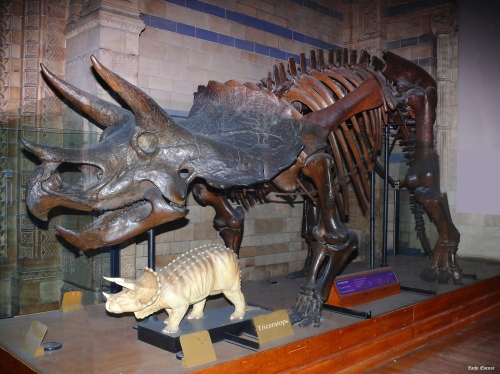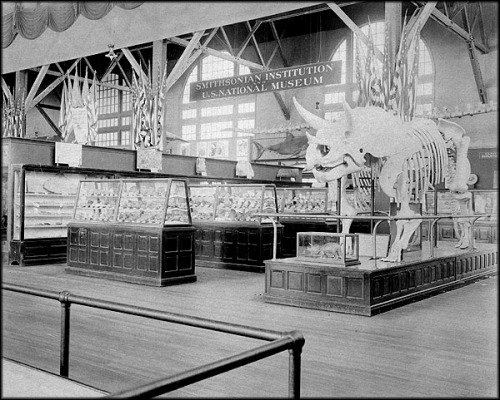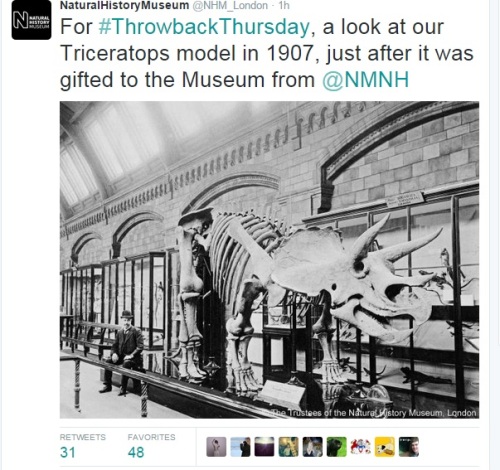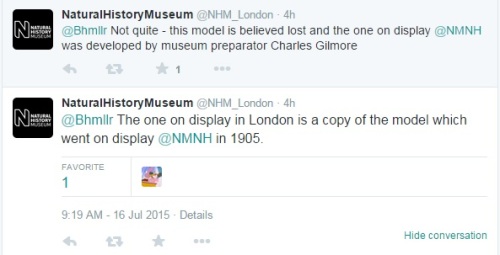
Triceratops at the Natural History Museum, London. Source
Don’t you hate it when you miss something glaringly obvious? I’ve never seen the Triceratops skeleton at London’s Natural History Museum in person, but I’ve seen enough pictures to know that it’s a little weird. Inaccuracies like the columnar feet, dragging tail, and vertical forelimbs can be attributed the display’s age, but the head doesn’t really look like any other Triceratops skull that’s ever been found. I had assumed that the funky frill and extremely long nasal horn were sculpted flourishes, but it turns out that no part of this Triceratops is real. It’s not a heavily-reconstructed original skeleton or even a cast – it’s a papier mâché model. And not just any model, but one that I’ve already written about in a different context.

The Lucas Triceratops model at the 1901 Pan-American Exhibition. Source
Frederic Lucas, an Assistant Curator at the United States National Museum, created this Triceratops in 1900 for the Smithsonian display at the Pan-American Exhibition in Buffalo, New York. A mix of corporate and government displays based around the themes of peace, prosperity, and technology, the Pan-American Exhibition lasted from May to November 1901 (it was cut short when President William McKinley was shot on the fairgrounds). The Smithsonian’s 7,500 square foot exhibit took nearly a year to prepare, and showcased specimens from all departments of the nascent institution. Indeed, the Smithsonian’s participation in this and other fairs around the turn of the century is significant because these attractions were the basis for the some of the first exhibits at the USNM. Displays initially created for fairs often found a home in the museum’s permanent galleries, and the fair exhibitions were generally used as a template for the first generation of Smithsonian exhibits.
The Triceratops model was meant to represent the glut of fossils from the western United States that the Smithsonian had recently acquired from O.C. Marsh. Perhaps because most of those specimens were still unpacked and unprepared (the USNM didn’t hire a dedicated fossil preparator until 1903), Lucas sculpted the skeleton freehand based on one of Marsh’s published illustrations. It’s noteworthy that Lucas was not a paleontologist – he was brought on board at the age of 21 with no formal training because of his talent for constructing taxidermy displays. At any rate, Lucas followed Marsh’s reconstruction – at the time the only Triceratops reconstruction available – religiously when constructing his full-sized model.

The Lucas Triceratops at the Louisiana Purchase Exposition in 1904. Source
After the Pan-American Exhibition, Lucas’s Triceratops made a second appearance at the 1904 Louisiana Purchase Exposition in St. Louis, Missouri. It was rendered obsolete shortly thereafter when Charles Gilmore assembled the world’s first real Triceratops skeleton at the USNM. As I’ve covered before, the act of physically manipulating the Triceratops fossils into a standing mount showed Gilmore that Marsh’s straight-legged reconstruction was a physical impossibility.
My understanding was that the Lucas model was lost or destroyed shortly after Gilmore’s real Triceratops went on display in 1905. I should have been more skeptical, however, because exhibits like this are almost never wasted. For example, Gilmore reported in 1943 that the Hadrosaurus cast displayed at the USNM before his arrival had been discarded due to wear and tear, but the mount had actually been given to the Field Museum in the 1890s. A couple months ago, I found out that Albert Koch’s chimeric mastodon (what he called “Missourium”) was purchased by Richard Owen on behalf of the British Museum and remounted. And just this year, the Smithsonian’s 112 year-old Stegosaurus model began a new life at the Museum of the Earth in Ithaca, New York.

Hey, that looks familiar! Source
The above tweet from the London Natural History Museum finally clued me in that the Lucas Triceratops had been hiding in plain sight for more than a century. The NHM (then the British Museum) received their Triceratops from the Smithsonian in 1907 (confirmed in the July 1907 issue of The Museums Journal), just when the Smithsonian had an extra Triceratops on hand. The London model is plainly not a cast of Gilmore’s 1905 mount, but it does resemble the Lucas model in most every detail, from the way the legs are posed to the exaggerated horns and frill. The only clear difference I can see is in the position of the head, which is much more elevated in the photos from the Buffalo and St. Louis expositions. However, I imagine the model would have been partially disassembled for transport. Perhaps when it was rebuilt in London the head ended up lower, whether by accident or design.
Unless there’s reason to think there were two copies of the Lucas Triceratops, I’d say the most parsimonious conclusion is that the London Triceratops is the very same model that was first displayed at the Pan-American Exhibition in 1901. Much like it’s long-time companion Dippy the Diplodocus, this Triceratops model is a century-old historic icon, one that has introduced generations upon generations of visitors to the enormity of deep time and the wonders of our prehistoric past. Inaccurate sculpture or not, it’s definitely something to preserve and to celebrate.
UPDATE: Shortly after I finished this post, @NHM_London responded to my inquiry with the following:

Did I speak too soon? Source
I’m dubious that the NHM Triceratops is a copy of Gilmore’s 1905 version, but hey, it *is* their museum. I’ll leave this post up for now and follow up when I find out more. I love a good museum mystery!
References
Gilmore C.W. (1905).The Mounted Skeleton of Triceratops prorsus. Proceedings of the U.S. National Museum 29:1426:433-435.
Gilmore, C.W. (1941). A History of the Division of Vertebrate Paleontology in the United States National Museum. Proceedings of the United States National Museum 90.
Howarth, E., Rowley, F.R., Ruskin Butterfield, W., and Madeley, C. (1908). The Museums Journal, Volume 7. Museums Association.


Fascinating story. I’d found some press clippings relating to this skeleton, but all of them were rather vague or contradictory (or both) regarding its origin. However, it does seem that the success of the Diplodocus mount provoked the museum to hunt for more dinosaurs (they also had an Iguanodon cast, of course).
Hi Ilja, thanks for the comment. I’m less certain about the origin of this model than I was when I wrote this (contradictory articles, like you said). It doesn’t help that it isn’t in the NHM online database. At least I think it isn’t – their new system is…not the most useful.
Reblogged this on The Jurassic Inquirer.
Hi, I am new to extinct monsters, but I’ve read a few of your posts already and something doesn’t make sense to me: why are out of all the triceratops skulls I’ve seen , some look really similar and others look completely different?! for example, you said in this post, “the head doesn’t really look like any other Triceratops skull that’s ever been found” but from pictures of the real NMNH mount and of “Hatcher” in your other posts, they look nearly identical. then there are skulls like “Lane” that don’t look like the NHM and NMNH triceratops and then the ones of “Kelsey” and the mount in the Los Angeles NHM. What is going on???!!
Hi Nathan, back in the day Marsh said that virtually every Triceratops he found was a different species. Now the general consensus is that there were just two – T. horridus (like Lane) and T. prorsus (like Hatcher).
What features are you looking at that make the NHM Triceratops (which is a sculpted model) look nearly identical to Hatcher? They look pretty different to me – note the backswept, flanged, and curvy frill and exaggerated beak and nasal horn on the NHM version.
well, the nose on hatcher is smaller, but the frill and general shape look similar, though not identical, that’s what i meant though, but thanks for clearing it up with the other mounts.
https://en.wikipedia.org/wiki/File:Torosaurus_and_Triceratops.tif
(the top one is apparently the holotype and it looks very similar (to me at least) to this) https://upload.wikimedia.org/wikipedia/commons/3/31/Triceratops-skull-Zachi-Evenor-002.jpg
although i know hardly anything on this subject so I’m probably wrong.
Great post thankkyou